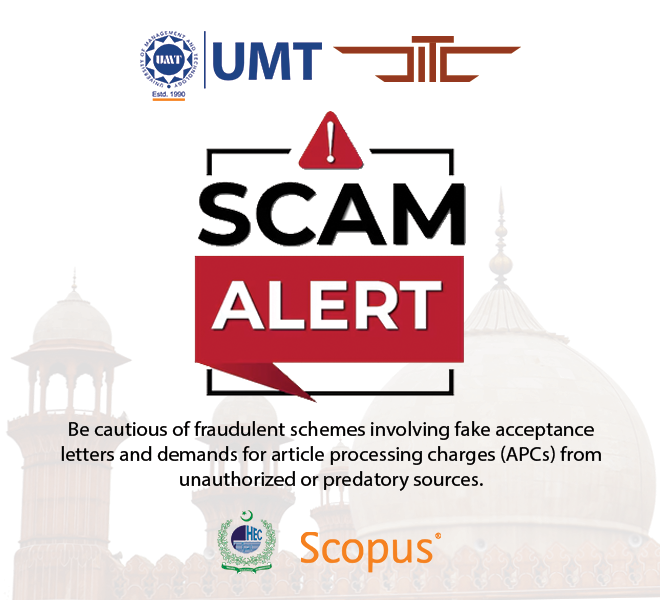A Stereotypical Approach towards Muslim and Islam in Australian Press: Framing Analysis of Daily Telegraph and Daily Courier Mail
Abstract
 Abstract Views: 320
Abstract Views: 320
Framing of the Muslims and Islam has been a debatable/is a contentious area of interest for researchers. This study is designed to analyze the approach of the Australian press towards the Muslims and Islam when it covers the terrorist incidents in Australia and in other part of the world, especially in the western countries. The news related to terrorist incidents and activities published during a six-month timeframe, that is, from October 2016 to March 2017, in two popular newspapers namely The Daily Telegraph (leaning towards the Liberal Party) and The Courier Mail (right-centered newspaper in its nature) was thoroughly analyzed. The major objective was to know how these newspapers frame the Muslims and Islam in their news contents when the issue of terrorism is under discussion. Despite the different political leanings of the selected newspapers, their approach towards the Muslims and Islam was found to be similar as both the dailies framed the terrorism related stories in a way to associate the Muslims and Islam with terrorism.
Keywords: Hijab, Islamophobia, Terrorist attacks, The Courier mail, The daily telegraph
Downloads
References
el‐Aswad, El‐Sayed. “Images of M uslims in W estern Scholarship and Media after 9/11.” Digest of Middle East Studies 22, no. 1 (2013): 39-56. DOI: https://doi.org/10.1111/dome.12010
Berelson, Bernard. Content Analysis in Communication Research. New York: The Free Press, 1952
Brasted, Howard. “Contested Representations in Historical Perspective: Images of Islam and Australian Press, 1950-2000.” In Muslims and Media Images: News versus Views. Oxford University Press, 2009.
Ciftci, Sabri. “Islamophobia and Threat Perceptions: Explaining anti-Muslim Sentiment in the West.” Journal of Muslim Minority Affairs 32, no. 3 (2012): 293-309.
Dunn, Kevin M. Mosques and Islamic Centres in Sydney, Representations of Islam and Multiculturalism. University of Newcastle, 1999.
Entman, Robert M. “Framing: Toward clarification of a Fractured Paradigm.” Journal of Communication 43, no. 4 (1993): 51-58.
Forrest, James., and Kevin Dunn. “Constructing Racism in Sydney, Australia's Largest Ethnicity.” Urban Studies 44, no. 4 (2007): 699-721. DOI: https://doi.org/10.1080/00420980601185676
Gamson, William A., and Andre Modigliani. “Media Discourse and Public Opinion on Nuclear Power: A Constructionist Approach.” American Journal of Sociology 95, no. 1 (1989): 1-37. DOI: https://doi.org/10.1086/229213
Gerges, Fawaz A. “Islam and Muslims in the Mind of America.” The Annals of the American Academy of Political and Social Science 588, no. 1 (2003): 73-89. DOI: https://doi.org/10.1177/0002716203588001006
Ghauri, Muhammad Junaid., Zahid Yousaf, and Zafar Iqbal. “Discourses on Islam and Muslims in Australia.” Journal of Political Studies 24, no. 2 (2017).
Hassan, Riaz. Australian Muslims: A Demographic, Social and Economic Profile of Muslims inAustralia. International Centre for Muslim and non-Muslim Understanding, 2015.
Hebbani, Aparna., and Charise-Rose Wills. “How Muslim women in Australia Navigate through Media (mis) representations of Hijāb/Burqa.” Australian Journal of Communication 39, no.1 (2012): 87-100.
Kabir, Nahid. “Representation of Islam and Muslims in the Australian Media, 2001-2005.” Journal of Muslim Minority Affairs 26, no. 3 (2006): 313-328. DOI: https://doi.org/10.1080/13602000601141281
Kaddour, Sarwet. “The Portrayal of Muslims Women in the Media.” Salam Magazine (2002).
Khan, Muhammad Khalil., Fei Wu, Cornelius B. Pratt, and Nadeem Akhtar. “Satires, Narratives and Journalistic Divides: Discourses on Free Speech in Western and Islamic News Media.” The Social Science Journal (2020): 1-19. DOI: https://doi.org/10.1016/j.soscij.2019.05.012
Kuhn, Rick. “The Rise of Anti-Muslim Racism in Australia: who Benefits?” Australian National University, March 27, 2007.
Kunst, Jonas R., Hajra Tajamal, David L. Sam, and Pål Ulleberg. “Coping with Islamophobia: TheEffects of Religious Stigma on Muslim Minorities’ Identity Formation.” International Journal of Intercultural Relations 36, no. 4 (2012): 518-532. DOI: https://doi.org/10.1016/j.ijintrel.2011.12.014
Neumann, Katharina., Florian Arendt, and Philip Baugut. “News and Islamist Radicalization Processes: Investigating Muslims’ Perceptions of Negative News Coverage of Islam.” Mass Communication and Society 21, no. 4 (2018): 498-523. DOI: https://doi.org/10.1080/15205436.2018.1430832
Orbe, Mark P., and Tina M. Harris. Interracial Communication: Theory into Practice. Sage Publications, 2013.
Perry, Barbara. “Gendered Islamophobia: Hate Crime against Muslim Women.” Social Identities 20, no. 1 (2014): 74-89.
Prasad, B. Devi. “Content Analysis.” Research Methods for Social Work 5 (2008): 1-20.
Robert Entman, M. “Framing: Toward Clarification of a Fractured Paradigm.” Journal of Communication 43, no. 4 (1993). DOI: https://doi.org/10.1111/j.1460-2466.1993.tb01304.x
Saeed, Amir. “Media, Racism and Islamophobia: The Representation of Islam and Muslims in the Media.” Sociology Compass 1, no. 2 (2007): 443-462. DOI: https://doi.org/10.1111/j.1751-9020.2007.00039.x
Sajid, Abduljalil. “Islamophobia: A New Word for an Old Fear.” Palestine-Israel Journal of Politics, Economics, and Culture12, no. 2-3 (2005).
Siraj, Syed Abdul. “Critical Analysis of Islamphobia in the West and the Media.” Global Media Journal: Pakistan Edition 5, no. 1 (2012):26-37.
Stemler, Steven E. “Content Analysis.” Emerging Trends in the Social and Behavioral Sciences: An Interdisciplinary, Searchable, and Linkable Resource (2015): 1-14. DOI: https://doi.org/10.1002/9781118900772.etrds0053
Suleiman, Michael W. “Islam, Muslims and Arabs in America: the Other of the Other of the Other...” Journal of Muslim Minority Affairs 19, no. 1 (1999): 33-47.
Tuchman. Gaye. Making News: A Study in the Construction of Reality. New York: The Free Press, 1978.
Vasta, Ellie., and Stephen Castles, eds., The Teeth are Smiling: The Persistence of Racism in Multicultural Australia. Sydney: Allen & Unwin, 1996.
Yusof, Sofia Hayati., Fauziah Hassan, Md Salleh Hassan, and Mohd Nizam Osman. “The Framing of International Media on Islam and Terrorism.” European Scientific Journal 9, no. 8 (2013): 104-121.
Copyright (c) 2021 Haseeb-ur-Rehman Warrich, Jamal ud Din , Rooh ul Amin Khan

This work is licensed under a Creative Commons Attribution 4.0 International License.

This work is licensed under a Creative Commons Attribution 4.0 International License. Authors retain copyright and grant the journal right of first publication with the work simultaneously licensed under a Creative Commons Attribution (CC-BY) 4.0 License that allows others to share the work with an acknowledgement of the work’s authorship and initial publication in this journal.








